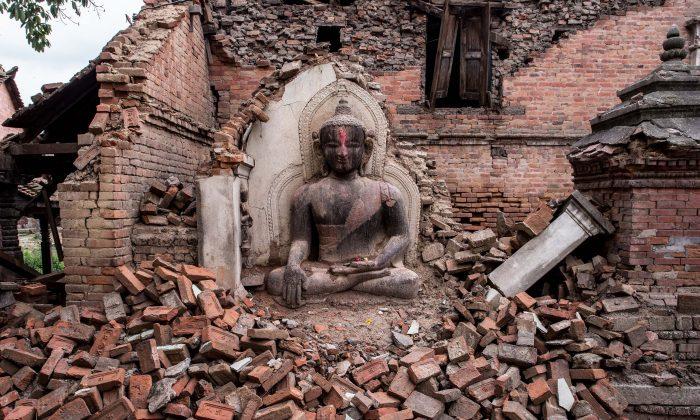
Frictional stresses along the more than 3000 kilometer-long, roughly 20 kilometer-tall (12.5 miles) fault planes marking the India-Asia plate boundary resist the plate motions. That means the stresses, caused by the India-Asia plate pushing, build up over decades or centuries before they are large enough to provoke a big earthquake along a section of one or more segments of the fault systems.
This most recent earthquake was particularly devastating because the rupture originated at a depth of about 12 kilometers (7.5 miles) below Earth’s surface, and caused slip along a nearly horizontal plane, according to the US National Earthquake Information Center. The shallow earthquake source, and the shallow fault zone geometry, caused intense shaking over a broad region. Only the largest earthquakes rupture to Earth’s surface.
Geological studies reveal an increased shaking hazard in the region because of relatively weak ancient lake sediments. This amplifies ground motions in Kathmandu and areas to the south in India.
Satellite and ground-based monitoring enables geophysicists to highlight areas with the greatest possibility for landslides and intense ground shaking. But the complexity and scale of Earth’s fault systems restrict the ability to answer the critical question: When will the next earthquake occur?
In the case of the Kathmandu earthquake, Nepalese and international geophysicists could only advise regional administrators to be vigilant. This advice did not, however, translate to strict zoning regulations and building codes, and some historic buildings had no mortar between bricks.
History of Hazards
The instant we click seatbelts in cars or airplanes, we acknowledge the inherent risk of travel. When it comes to geohazards, decades of earthquake and satellite-based ground deformation monitoring reveal the most seismically active areas in the world, even day-by-day activity.
Also, archaeological digs of ancient structures, historic documents, and studies of ancient soil levels provide clues of damaging repeat earthquakes in some areas. Many of these high-risk regions have well-developed public information plans, and first responders practice for the eventuality of damaging earthquakes.
Tourists to the Mediterranean region, for example, benefit from the more than 4,000-year written record of earthquakes, volcanoes, and associated tsunamis. These historic records highlight the potential risk of buildings that lack steel reinforcement (rebar) and cross-beams to reduce the damage of earthquake surface waves.
Indeed, construction styles in historic districts of many cities, including Kathmandu, are wholly inadequate to resist the intense ground shaking from devastating shallow earthquakes. Four of the seven World Heritage Sites in Khandahar were destroyed, and visitors were killed at the sites and in the surrounding areas.
Plan Ahead
What can travelers do before they leave?
Students in my Geohazards and their Mitigation class compiled a few key steps to disaster preparedness, gathered from national and international guidelines and case studies of earthquake-hazard mitigation.
Just as we consult weather predictions when packing suitcases, travelers can consider the earthquake, volcano, and other related hazards from landslides, avalanche, and tsunamis worldwide.
Know the layout of the hotel or residential neighborhood, the tsunami safety point, and review the guidelines for disaster response on the Federal Emergency Management Agency FEMA, United States Geological Service, or national websites.
In earthquake-prone areas, tourists can request information on the age of hotels, the building standard, and preparedness for earthquakes. News reports indicate that many sightseers and tourists were killed in the historic districts of Kathmandu, constructed before building standards were established. Adobe (unfired brick) and brick structures lacking cement are particularly susceptible to damage. This was the case in many recent earthquakes, including in Izmit, Turkey in 1999, Bam, Iran, in 2003, and L'Aquila, Italy in 2009.
Centuries-old buildings are unique and beautiful, but visitors with choices may wish to choose beds in new structures adhering to strict building codes.
Best practice for all hotels and guest houses includes simple instructions for reducing harm from hazards, such as indicating earthquake and tsunami meeting points. Well-prepared staff are also trained in disaster response and have emergency water and medical supplies.
With a bit more effort than clicking a seatbelt, all world travelers can take precautions to minimize risk. And in developing countries, tourism dollars can lead to changes in building and zoning regulations.
Students from the Geohazards and their Mitigation class at the University of Rochester contributed to this article. This article was originally published on The Conversation. Read the original article.


Friends Read Free